|
|
Qix
|
Name:
|
Qix |
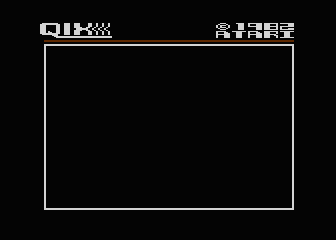 |
| Company: | Atari | |
|
Model #:
|
CX-5213 | |
|
Programmer:
|
Mike Horowitz & Allen Wells
(GCC) |
|
| Year: | 1982 | |
|
Released?
|
Yes
|
|
|
Notes:
|
A completely
different port exists for the Atari 400/800 |
Pronounced 'kicks', this Taito coin-op mesmerized players with
its unique gameplay which required the player to draw lines on
the screen in order to fill in the screen and capture
area. The player had to avoid the evil titular Qix which
moved rapidly and randomly around the screen and tried to touch
the line the player was drawing. Players also had to make
sure not to pause too long when drawing or a spark would race up
the line and zap them. Qix was insanely popular on the
arcade, at least for a time. Once dedicated players
learned that the Qix's movement was indeed random and pattern
memorization was impossible, its popularity dropped off
quickly. It turns out that players wanted a game they
could actually master, rather than a game full of randomness.
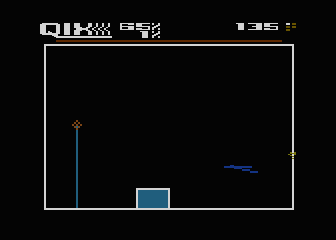
Qix's gameplay is fairly simple. You must draw a line that connects one side of the screen with another. Upon doing so, the shape you drew will fill in and you will receive credit for capturing a certain percentage of the screen area. If you manage to capture 75% or more of the screen area then you will move on to the next level. There are two different ways to draw a line in Qix, if the player holds the bottom button then they draw a blue line which is faster but the player scores less points when they fill in the area. If the player holds the top button they draw a red line which is much slower but scores double the points when it fills in.
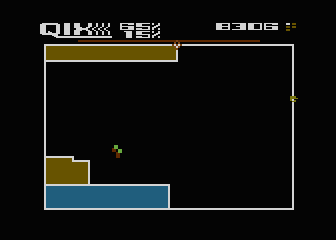
It wouldn't be much of a game with out a few enemies trying to destroy your magic pencil. Your main opponent in the evil Qix who appears as a square bunch of lines that move randomly around the screen. If Qix touches a line you're actively drawing you will lose a life and the line will be erased. On higher levels two Qix appear, but this can be used to your advantage. If you manage to 'Split the Qix' by drawing a line between them you'll automatically complete the level and all points will be doubled. If you mange to split the Qix again points will be tripled, then quadrupled, etc. Your other major enemy is the Sparx. Sparx are little balls that travel around edges of the screen and travel down the lines you've drawn (they will not travel down the line you're currently drawing). If one of these touches you, you'll lose a life. Each level starts with two Sparx, but once the timer bar at the top of the screen finishes counting down two more will appear. After the timer counts down again the Sparx will turn into Super Sparx which are faster and more intelligent the regular Sparx so don't dilly dally. The player must also watch out that they don't stop drawing a line until it's complete or the Fuse will appear and move up the line and try and zap you. Thankfully you can get rid of the Fuse by starting to draw again but if you stop again the Fuse will pick up where it last left off.
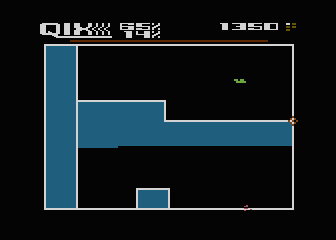
Qix offers four different skill levels which control how much of the screen area the player must capture and how fast and intelligent the enemies are. On Novice the player must only capture 50% of the area and the Sparx and Fuse are absent. Qix isn't very intelligent and doesn't actively seek out the player. On Skilled the player must capture 65% of the area and the Sparx and Fuse are present but slow and the Super Sparx are absent. Qix is a bit more intelligent on this variation. Advanced is the same difficulty as the arcade game and the player must capture 75% of the area. Qix has a bit of intelligence and the Sparx and Fuse move at a normal pace. Expert is for true Qix masters only. Not only must the player now capture 85% of the area, but Qix is highly intelligent and will actively seek out the player. The Sparx and the Fuse are now much faster than they were in the arcade, making the game very difficult.
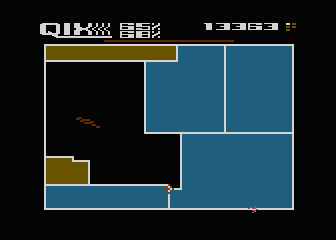
While Qix may have had a short life in the arcades, it was ported to many home computers and consoles with varying degrees of faithfulness. As was the norm at the time, both the Atari 400/800 and 5200 received a port of Qix. However much like as with Dig Dug and Centipede, the Atari 5200 version was a completely different more arcade accurate port. Why Atari decided to create and release two different ports is unknown, but the Atari 5200 version is widely considered to be the superior version. At the time of its release, the 5200 and 400/800 ports were the only home versions until several computer ports were released in 1989. The Atari 5200 truly was the home arcade machine.
| Version | Cart Text | Description |
| ?/??/82 | QIX EPROM Cartridge |
Final version |
